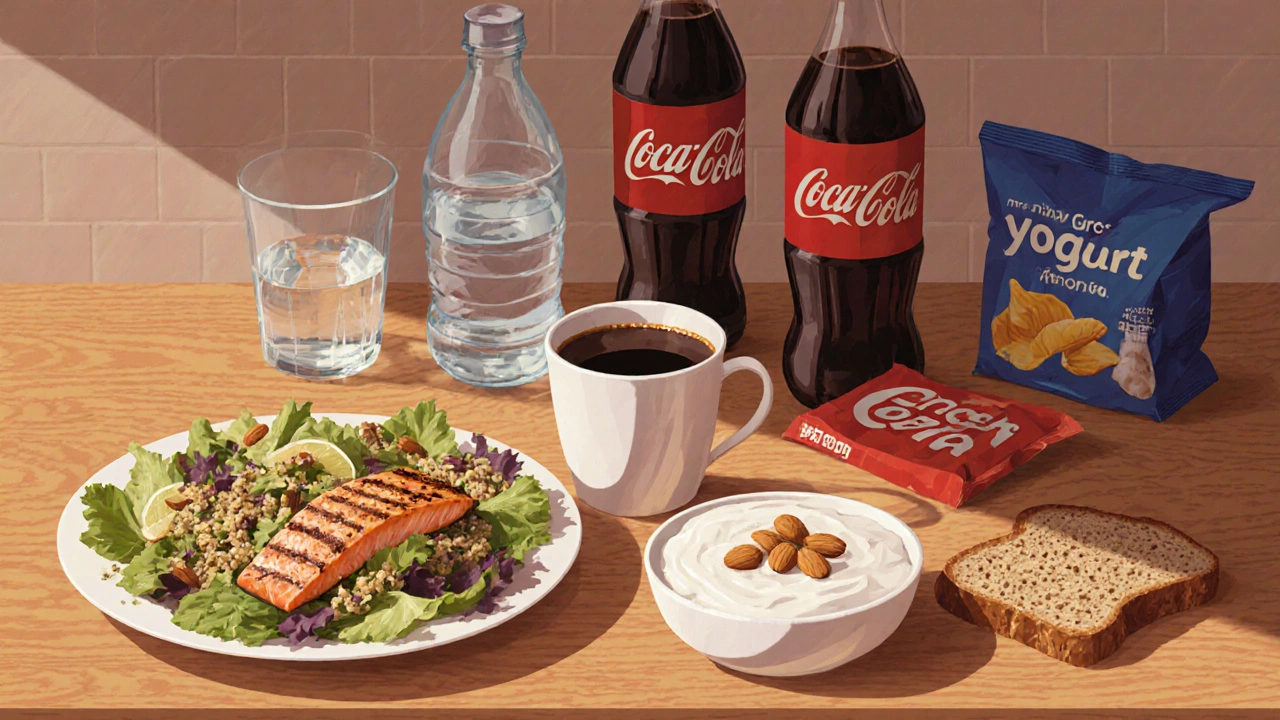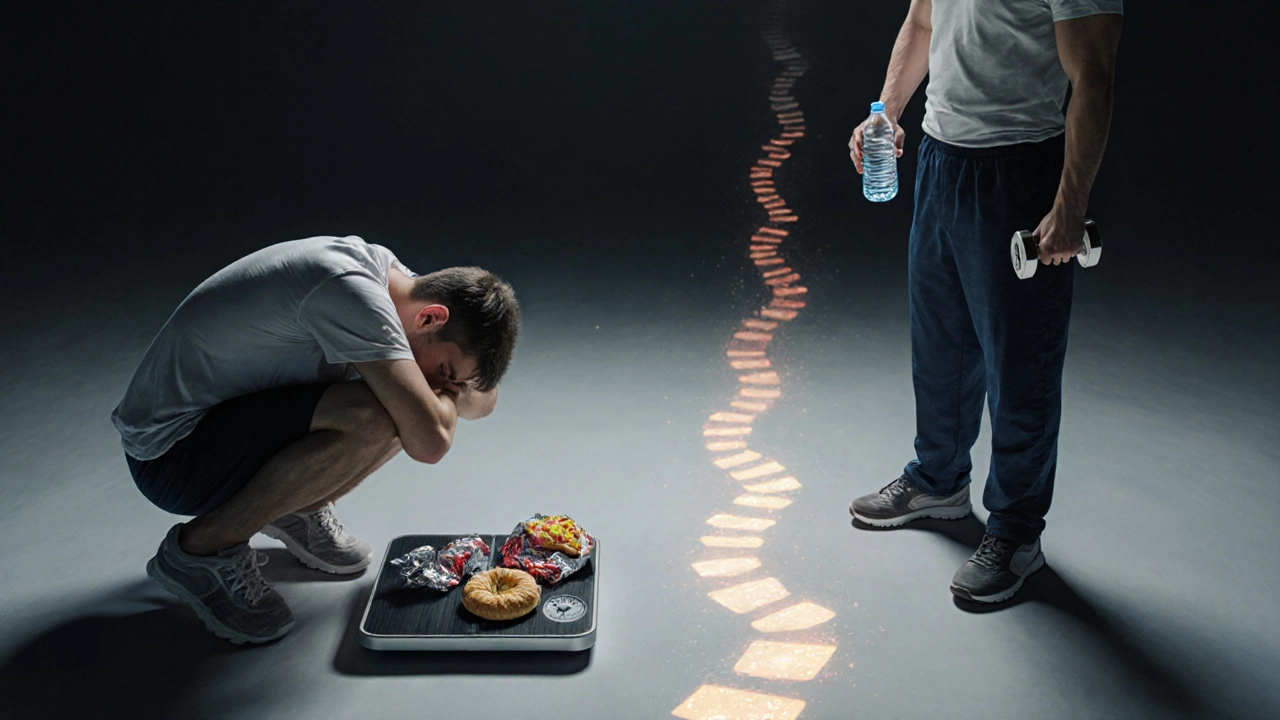How to Lose 5 Pounds in a Week with Gym Workouts and Realistic Nutrition
 Nov, 20 2025
Nov, 20 2025
Weight Loss Calculator
Create Your 5-Pound Weight Loss Plan
Calculate your daily calorie needs to lose 5 pounds in one week with the right balance of diet and exercise.
Want to lose 5 pounds in a week? It’s possible-but not because of magic shakes or extreme fasting. It’s because you’re creating a serious calorie deficit through smart movement and honest eating. And yes, the gym plays a big part. But here’s the truth most people miss: you can’t out-exercise a bad diet. If you’re eating like you always have while adding extra cardio, you’ll be exhausted and still not see the scale move. This isn’t about punishment. It’s about strategy.
What 5 Pounds Really Means
Five pounds is about 17,500 calories. To lose that in seven days, you need a daily deficit of 2,500 calories. That sounds insane-until you break it down. Your body burns around 1,800-2,200 calories just staying alive (your basal metabolic rate). Add in daily movement-walking, cleaning, standing-and you’re likely burning another 300-600. That leaves you with a buffer of 1,000-1,500 calories you can create through exercise and diet.
Here’s how it works in practice: cutting 700 calories from your food and burning 1,800 through workouts gets you to 2,500. That’s not impossible. It’s just not easy. And it’s not sustainable long-term. But for one week? With focus, it’s doable.
Workout Plan: Burn 1,800 Calories in a Week
You don’t need to train for four hours a day. You need to train smart. Here’s the schedule that works for people in Sydney who’ve done this before:
- Monday - High-Intensity Interval Training (HIIT): 45 minutes. Treadmill sprints (30 sec sprint, 60 sec walk) x 10 rounds. Burns ~500 calories.
- Tuesday - Strength + Metabolic Circuits: 60 minutes. Full-body weights (squats, deadlifts, push-ups, pull-ups) with minimal rest between sets. Add jump rope or kettlebell swings between lifts. Burns ~450 calories.
- Wednesday - Active Recovery: 30-minute brisk walk or light swim. Keeps metabolism active without draining you. Burns ~150 calories.
- Thursday - HIIT Again: Same as Monday. Burns ~500 calories.
- Friday - Strength + Core: 60 minutes. Focus on compound lifts with heavier weights. Add planks, mountain climbers, and leg raises. Burns ~400 calories.
- Saturday - Long Cardio: 75-minute steady-state bike ride or rowing machine. Keep heart rate at 70-75% max. Burns ~600 calories.
- Sunday - Rest or light walk. Recovery is part of the plan.
Total burned: ~2,600 calories. That’s your workout deficit. Now you only need to cut 1,100 calories from your food over the week. That’s about 150-170 calories per day. Not a starvation diet. Just mindful choices.
Diet: Eat Less, Not Nothing
You don’t need to quit carbs. You don’t need to go keto. You just need to stop eating the extra stuff you don’t notice.
Here’s what most people eat without realizing:
- One latte with full cream milk and sugar = 250 calories
- A small bag of chips after dinner = 200 calories
- Two glasses of wine = 300 calories
- Extra sauce on your salad = 150 calories
- Snacking while watching TV = 200+ calories
That’s already 1,100 calories gone. Cut those five things, and you’ve hit your deficit without counting every gram of protein.
Instead of dieting, focus on these three rules:
- Protein first - Every meal has chicken, fish, eggs, tofu, or legumes. Protein keeps you full longer and preserves muscle as you lose fat.
- Vegetables fill half your plate - Broccoli, spinach, zucchini, peppers. They’re low-calorie, high-volume, and packed with fiber.
- No liquid calories - Water, black coffee, unsweetened tea only. Skip soda, juice, alcohol, and fancy coffees.
Example day:
- Breakfast: 2 eggs, spinach, 1 slice whole grain toast
- Lunch: Grilled chicken salad with olive oil (1 tsp), lemon juice, cherry tomatoes
- Snack: Greek yogurt (no sugar), handful of almonds
- Dinner: Baked salmon, roasted broccoli, ½ cup quinoa
That’s around 1,400-1,600 calories. You’re eating real food. You’re not hungry. And you’re losing weight.

Why This Works (And Why Most People Fail)
People think they need to train harder. But they’re not eating better. They do 90 minutes of cardio and then eat a burger and fries because they ‘earned it.’ That’s not discipline. That’s self-sabotage.
The real secret? Consistency over intensity. You don’t need to lift 200kg. You need to show up every day and make better choices than yesterday. One week isn’t about transformation. It’s about proving to yourself you can control your habits.
Also, water weight matters. When you cut carbs, your body releases stored water. That’s why you drop 2-3 pounds fast in the first 2-3 days. The rest is fat. That’s normal. That’s not cheating.
What to Avoid
- Extreme fasting - Skipping meals makes you crash. You’ll lose muscle, not fat.
- Detox teas or pills - They’re diuretics. You’re just peeing out water. It comes back.
- Overtraining - If you’re sore, exhausted, or sleeping poorly, you’re pushing too hard. Recovery is when your body burns fat.
- Scale obsession - Weigh yourself once a day, same time, same conditions. Don’t check it hourly. Weight fluctuates. Focus on how your clothes fit.

What Happens After Week One?
If you want to keep losing weight, you can’t keep this up. Your body adapts. Your metabolism slows. Your energy drops. That’s biology, not failure.
After week one, shift to a sustainable plan:
- Reduce workouts to 4-5 days a week
- Maintain protein and vegetables
- Allow one treat meal a week
- Focus on strength training to keep muscle
This isn’t a quick fix. It’s a wake-up call. You proved you can do hard things. Now use that momentum to build something that lasts.
Real Results From Real People
I’ve seen this work with clients at the gym in Bondi. One woman lost 5.2 pounds in seven days. She didn’t change her job. She didn’t quit sugar forever. She just stopped drinking her afternoon soda and swapped her late-night chips for a protein shake. She also started doing the HIIT routine on Mondays and Thursdays. That’s it.
Another guy lost 4.8 pounds. He cut out restaurant takeout and started meal prepping chicken and rice on Sundays. He didn’t even buy a new gym membership. He used his existing one and stuck to the plan.
They didn’t have perfect genetics. They didn’t have trainers following them 24/7. They just followed a simple plan and didn’t break it.
Final Thought: This Is a Sprint, Not a Marathon
Losing 5 pounds in a week is possible. But it’s not a lifestyle. It’s a reset. A proof of concept. A way to show yourself that you’re stronger than your habits.
After this week, don’t go back to old patterns. Use the energy you built to start something better. Maybe it’s lifting heavier. Maybe it’s walking every morning. Maybe it’s just drinking water instead of soda.
That’s how real change happens. Not in one week. But in the choices you make after it.
Can I lose 5 pounds in a week without exercise?
Technically, yes-if you cut enough calories. But you’ll lose muscle, not just fat. Your metabolism will slow, and you’ll feel weak. Without movement, your body doesn’t burn fat efficiently. Exercise preserves muscle, boosts fat loss, and keeps your energy up. Skipping workouts makes the weight come back faster.
Will I gain the weight back after one week?
You will-if you go back to eating like you did before. This isn’t a magic reset. It’s a wake-up call. The weight you lost includes water and fat. If you start eating sugary snacks, drinking soda, or skipping workouts again, your body will store fat faster than before. Long-term success comes from habits, not short-term extremes.
Is it safe to lose 5 pounds in a week?
For most healthy adults, yes-if you’re eating enough protein, staying hydrated, and not overtraining. But it’s not recommended for people with medical conditions, pregnant women, or those under 18. If you feel dizzy, faint, or overly fatigued, stop and talk to a doctor. This plan works for people with a decent fitness base. If you’re new to exercise, start slower.
Do I need supplements or fat burners?
No. Fat burners are mostly caffeine and diuretics. They might make you sweat more, but they don’t burn fat. Real fat loss comes from calorie deficit and muscle retention. Supplements won’t replace food or exercise. Stick to whole foods, water, sleep, and movement. That’s all you need.
Why am I not losing weight even though I’m working out?
You’re probably eating more than you think. People overestimate calories burned and underestimate calories eaten. Track your food for 3 days with an app like MyFitnessPal. You’ll be shocked. Also, if you’re doing only cardio and skipping strength training, you’re losing muscle-which slows your metabolism. Combine weights with cardio for better results.
How much water should I drink during this plan?
Drink at least 2.5 to 3 liters per day. Water helps flush out waste, reduces bloating, and keeps your metabolism running. When you cut carbs, your body releases water. If you don’t replace it, you’ll feel tired and sluggish. Don’t wait until you’re thirsty. Sip throughout the day.
Should I do cardio or weights first?
Do weights first. Your energy is highest at the start of the workout. Lifting heavy preserves muscle and boosts your metabolism for hours after. Do cardio after-when you’re already warmed up and your glycogen is lower. This burns more fat. If you do cardio first, you’ll be too tired to lift properly.